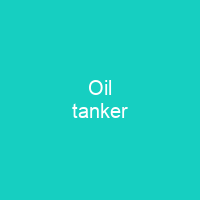Oil tanker

An oil tanker is a ship designed for the bulk transport of oil or its products. Crude tankers move large quantities of unrefined crude oil from its point of extraction to refineries. Product tankers are designed to move refined products from refineries to consuming markets. Oil tankers have been involved in a number of damaging and high-profile oil spills.
About Oil tanker in brief
 An oil tanker is a ship designed for the bulk transport of oil or its products. Crude tankers move large quantities of unrefined crude oil from its point of extraction to refineries. Product tankers are designed to move refined products from refineries to consuming markets. Oil tankers have been involved in a number of damaging and high-profile oil spills. As a result, they are subject to stringent design and operational regulations. The technology of oil transportation has evolved alongside the oil industry. The first modern commercial exploitation of oil dates back to James Young’s manufacture of paraffin in 1850. The modern oil tanker was developed in the period from 1877 to 1885. The average cost of transport of crude oil by tanker amounts to only US$5 to USD 8 per cubic metre. The size classes range from inland or coastal tankers of a few thousand metric tons of deadweight to the mammoth ultra large crude carriers of 550,000 DWT. Tankers move approximately 2. 0 billion metric tons of oil every year. In 1863, two sail-driven tankers were built on England’s River Tyne. These were followed in 1873 by the first oil-tank steamer, Vaderland, which was built by Palmers Shipbuilding and Iron Company for Belgian owners. In 1876, brothers of Alfred Nobel, founded Branobel, one of the largest oil companies in the world. Ludvig was a pioneer in the development of early oil tankers.
An oil tanker is a ship designed for the bulk transport of oil or its products. Crude tankers move large quantities of unrefined crude oil from its point of extraction to refineries. Product tankers are designed to move refined products from refineries to consuming markets. Oil tankers have been involved in a number of damaging and high-profile oil spills. As a result, they are subject to stringent design and operational regulations. The technology of oil transportation has evolved alongside the oil industry. The first modern commercial exploitation of oil dates back to James Young’s manufacture of paraffin in 1850. The modern oil tanker was developed in the period from 1877 to 1885. The average cost of transport of crude oil by tanker amounts to only US$5 to USD 8 per cubic metre. The size classes range from inland or coastal tankers of a few thousand metric tons of deadweight to the mammoth ultra large crude carriers of 550,000 DWT. Tankers move approximately 2. 0 billion metric tons of oil every year. In 1863, two sail-driven tankers were built on England’s River Tyne. These were followed in 1873 by the first oil-tank steamer, Vaderland, which was built by Palmers Shipbuilding and Iron Company for Belgian owners. In 1876, brothers of Alfred Nobel, founded Branobel, one of the largest oil companies in the world. Ludvig was a pioneer in the development of early oil tankers.
He first experimented with carrying oil in bulk on single-hulled barges. One of these is the naval replenishment oiler, a tanker which can fuel a moving vessel. The other was the Zoroaster, which carried its engine room aft and had a set of vertical watertight compartments for extra buoyancy. The Zoroaster was small enough to sail to the Caspian by way of the Baltic Sea, Lake Ladoga, Lake Onega, the Rybinsk Canals and the Volga River. The ship had a length of 21 metres, a beam of 8 metres and a draft of 2 metres. It was built in 1883 by British engineer Henry F. Swan, who designed a large oil tanker for the British oil company F.W. Nobel. In the early 1850s, oil began to be exported from Upper Burma, then a British colony. The oil was moved in earthenware vessels to the river bank where it was then poured into boat holds for transportation to Britain. By 1871, the Pennsylvania oil fields were making limited use of oil tank barges and cylindrical railroad tank-cars similar to those in use today. The vessel’s use was curtailed by U.S. and Belgian authorities citing safety concerns. By the mid-19th century, the first successful oil tanker was carried its kerosene cargo in two iron tanks joined by two iron pipes. One was a midships tanker, which had a 21 metres overall length of 56 metres.
You want to know more about Oil tanker?
This page is based on the article Oil tanker published in Wikipedia (as of Dec. 14, 2020) and was automatically summarized using artificial intelligence.












